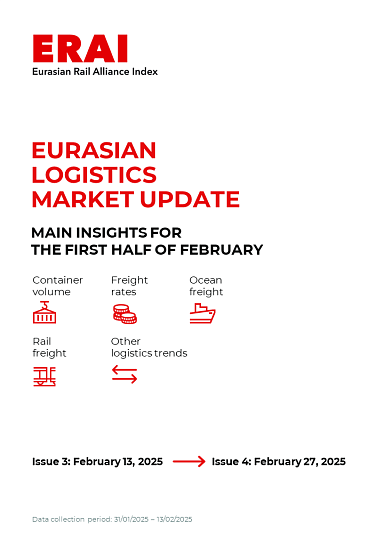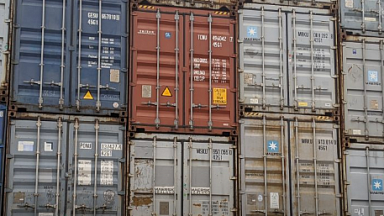China-Europe logistics market
Demand outlook
-
In January, the European industry continued to experience a decline in production, new order volumes, and employment (although the pace of overall downturn was the slowest since May 2024) [S&P Global]. The slowdown in the EU economy and decreased demand in key sectors pose risks for cargo flows between Europe and China, particularly in the segments of consumer goods and automobiles.
-
According to a recent report by Rhodium Group, imports to China are expected to remain weak over the next 12 to 18 months due to low consumer demand, further limiting the supply of European goods. At the same time, exports from China to Europe will continue to rise, as the EU will struggle to effectively protect its market from Chinese products.
-
European manufacturers are intensifying cost control measures; in this context, Mercedes-Benz has announced a 10% reduction in logistics costs since February 1 [The Loadstar]. The cost optimization trend among automakers may lead to a shift towards cheaper shipping methods — specifically maritime shipping.
-
In January, the volume of rail container freight between China and Europe decreased by 5% MoM, primarily due to a reduction in shipments via the Middle Corridor (-23% MoM) and a significant decline in volumes from Europe to China (-48% MoM).
-
The market is experiencing a seasonal decrease in demand following the holidays in China. In the short term, maritime trade faces pressure from excess capacity and intense competition amid low seasonal demand. Long-term market trends will be influenced by: the resumption of transit via the Red Sea, additional capacity entering the market and exacerbating supply-demand imbalances, economic conditions in China and Europe, as well as U.S. tariff policies and subsequent shifts in global trade.
Freight rate trends
-
Rail freight rates for the major China-Europe routes (SOC) have decreased by 4% over the past month. The average rates range from $5 550 (Chengdu) to $7 200/FEU (Shenzhen). Container lease rates have dropped by about 30%.
-
WCI Shanghai-Rotterdam dropped by 29% MoM, to $3,125/FEU (-29% YoY) [Drewry]. Strategic blank sailings have played a crucial role in balancing the market, effectively preventing a sharper decline in rates. Freight rates may continue to decrease in both the short-term and the longer-term. Carriers are making efforts to stabilize prices in March.
Other trends
- Starting April 1, 2025, the EU’s Import Control System 2 (ICS2) will be implemented for rail and road transport [European Commission]. The new requirements mandate the submission of an expanded set of «safety and security» data in the import declaration (ENS). This includes six-digit HS codes for each item in the shipment, an «acceptable description,» and comprehensive information about both the buyer and seller.
China-EAEU logistics market
Import and export trends
-
According to the latest survey by the Bank of Russia inflation is expected to reach 6.8% in 2025, which is higher than previous expectations. This indicates a persistence of high price pressures that may lead to a reduction in the population’s purchasing power, particularly in the context of slowing growth in real wages. The weakening of the ruble and the high key interest rate will negatively impact the import of high-margin goods, such as cars and electronic devices. In 2025, sales of all types of vehicles in Russia may decrease by 10% in some baseline scenarios and by up to 30% in pessimistic ones [RBC, NRA]. A decline in demand for smartphones is also anticipated—approximately by 5% [Kommersant].
-
As of early February, around 400 empty well wagons had accumulated at the Zabaikalsk railway station due to dispatch restrictions. Starting from February 6, Russian Railways eased these restrictions, allowing the dispatch of up to three container trains, the situation is gradually improving [InfraNews].
-
Over the past two weeks, rates for imports from China via direct rail connections have significantly decreased, with a downward trend also observed in multimodal transport. The cost of transporting via direct train is approximately $7 800/FEU (COC), which is about ~$1 000 lower than the previous level. Rates for shipments through Far Eastern Russian ports reduced at about $200, standing at approximately ~$5 800/FEU (SOC), of which around $4 500 attributed to the rail component.
-
During the final board meeting of Russian Railways (RZD), held on February 12, the launch of a new tariff system was announced, set to take effect on January 1, 2026 [TASS]. The foundation of the new model is a «fair and economically justified tariff,» which incorporates components aimed at addressing infrastructure development goals and takes into account the company’s key debt indicators.
Other trends
-
In January 2025, Russian Railways (RZD) transported 682,3 thousand TEUs, marking a 9,8% YoY increase [RZD]. Of this, 253.8 thousand TEUs were transported on domestic routes, reflecting a 0.5% decline. The number of laden containers amounted to 490.1 thousand TEUs, a 10.8% YoY increase.
-
Kazakhstan Railways has imposed a ban on accepting all cargo and empty owned or leased wagons for transportation from Dostyk station to Altynkol station and vice versa. The restrictions are set to remain in effect until the end of 2025 [APK News, LogiStan].
-
The Ministry of Transport of Russia has prepared a draft resolution for the Government of Russia outlining new rules for the movement of empty freight wagons from port stations. These changes will allow for the transportation of empty wagons over greater distances than currently permitted.





